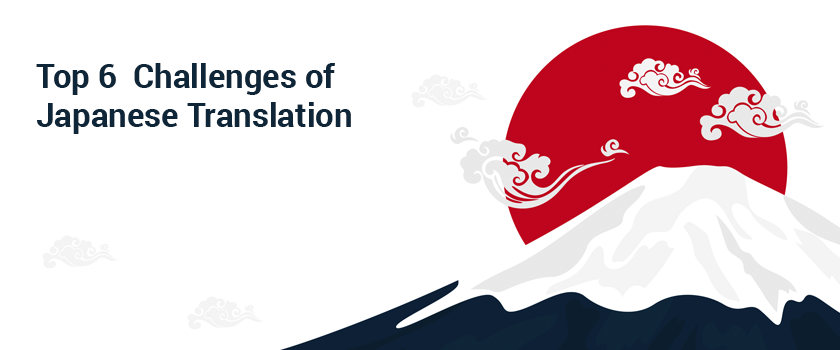Top 6 Challenges of Japanese Translation
By: Antonia Ava Posted on Tue, 24-03-2020

Japanese is an East Asian Language and it has a relation to other languages like Korean, Ainu, Austroasiatic, and Altaic to some extent and this relation does not gain acceptance. The importance of the Japanese language can be well defined by One-hundred and forty million native speakers in Japan and Japan has the second-largest economy in the world followed by China.
Let's see the challenges which we can overcome while learning the Japanese language and make our Japanese learning journey enjoyable.
Kanji Complex Writing Style
The Japanese language has a very complicated writing style called Kanji and it comprises of complex characters and concepts. Kanji's writing style has different strokes that depict their meaning instead of characters. It has more than 2000 characters with few other characters which are rarely used. With such a large number of characters, it is very difficult to learn and translate the Japanese language. We at Mars Translation specialize in Japanese translation services and provide consistent and flawless results for websites, documents and other types of content.
How to Understand Kanji Writing Style
- Learn Kanji symbols that look like baby sketches.
- Use Picture mnemonics or hints.
- Use word mnemonics
Literal Translation is Not Enough
Many words and phrases in the Japanese language do not have a literal meaning in English which makes it very difficult to learn and translate the Japanese language. The basic problem is retaining original meaning while writing it in another language. Learning and translation of concepts is a great challenge faced by Japanese learners and translators.
Let's See Some of the Mistakes Which Are Made by Word to Word Translation.
- Taco Bell has made its Japanese website Cheesy chips which were wrongly translated as low-quality chips.
- Crunchwrap supreme was wrongly translated as supreme court beef.
- The slogan ‘We have got nothing to hide’ was wrongly translated as what did we bring here to hide it.
It is quite evident from these examples that word to word translation can destroy the message and ruin your brand image. The literal translation is not the solution and it is important to take the intended meaning into account and translate the words accordingly. The contextual translation is even more important for translating marketing content and you must pay special attention to maintain the persuasive tone so that the translated version can have the same impact as that of the original text.
How to Overcome This Challenge
Many Japanese words are retrieved from the Chinese language. To retain the literal meaning of translation one should know the cultural nuance of the region. Therefore, it is better to seek professional assistance by native translators who can provide localized translations and deliver the message clearly.
Different Insertion of Verbs and Subjects
In the Japanese language, there are many grammar rules and dialects which are less known than other languages, especially in the case of subjects and verbs. In
English language subjects and verbs are present at the start of the sentence whereas in Japanese language verbs are placed at the end of the sentence. Moreover in Japanese subjects are frequently understood, it means readers need to understand the subject of the sentence by the sentence.
How to Overcome this Challenge
- Learn grammar
- Learn variability in word order.
Plural Noun
There is no difference between singular and plural forms in the Japanese language. The learners and translators need to depend on the context of the words, otherwise, there is no way to check whether the word is singular or plural which makes Japanese learning and translation a difficult task. Furthermore, because of the ambiguity of plural nouns, it is impossible to check the counting reasons in case of pronouns and adjectives.
How to Overcome This Challenge
- By adding several suffixes to the noun.
- By using counters
Confusion in Prepositions
The use of Japanese pronoun is different from other languages. There are a variety of pronouns in the Japanese language that relies on gender and style of speech. To a clear context, pronouns are not used. It is very important to learn when and how to use them.
How to Overcome This Challenge
- Learn how to say I and You
- Learn personal pronouns and third-person pronouns
- Learn plural personal pronouns
Difficulty in Tenses
There are two tenses in the Japanese language that are past and non-past. To describe the present and future, you need to use the non-past tense. It becomes difficult when you need to translate it in English because English has three tenses past, present and future.
How to Overcome This Challenge
- Listening
- Reading
- Writing
- Speaking
- Keep practicing
Conclusion
Japanese translation is indeed a tedious task. To get reliable results, you should look for a subject matter expert, who is aware of all the challenges of the language and provides you with impeccable translation. Mars Translation has a pool of native translators who are subject matter experts of their fields and provides you state of the art Japanese translation services in rapid turnaround time and economical rates.

Africa is the second largest and second most populous continent. As recent statistics suggest, 1,486,275,887 is the current population of
Read more
dxf: DXF is a CAD data file format developed by Autodesk for CAD data exchange between AutoCAD and other software. docx:
Read more
Mars Translation can help you extract the texts in a DXF file and convert them into a XML file so
Read more
Mars Translation can help you extract the texts in a DWG file and convert them into a Word file so
Read more
No state on the western side of the globe can compare the strategic geographic location, diverse multilingual workforce, and attention
Read more
San Diego is California's second-largest city, and it has a population of 1.3 million from which three million residents are
Read more
Dallas is the largest state in Texas after Houston and San Antonio. It is the ninth most populous city in
Read more
In this day and age, users love to consume video content. Statistics show that almost 90% of all internet users
Read more
Virtual reality is transforming our imaginative worlds into existence. Since childhood, we used to create visionary kingdoms and act like
Read more